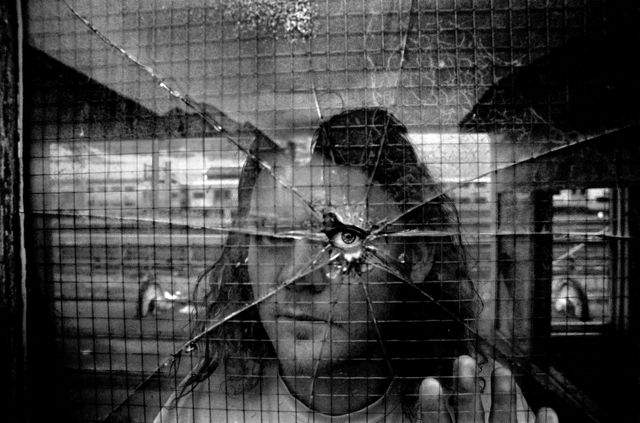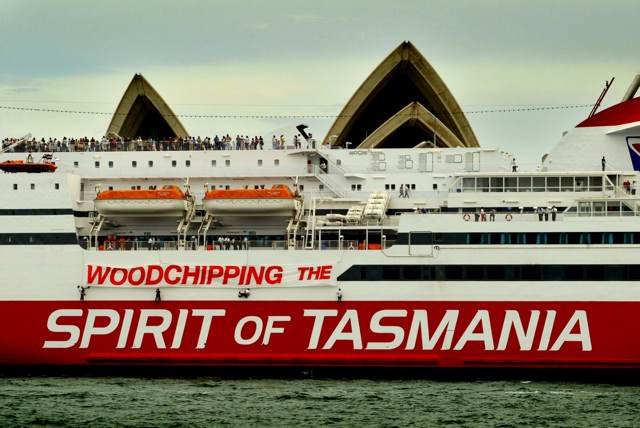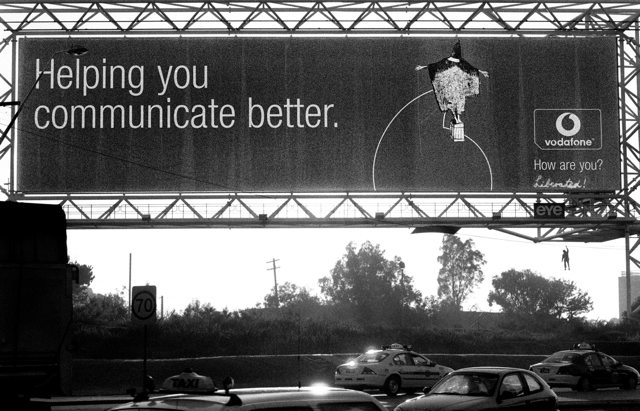Concrete Playground Meets Photographer Dean Sewell
Dean recently sat down with Concrete Playground to talk about the Lonely Station, photography and the usefulness of good rope skills.
According to Dean Sewell — Moran Prize winning photographer and part of the Oculi collective — there was this duffel bag. Inside it was a banner a hundred foot long, decorated with two words. This was on the maiden voyage of the Sydney to Hobart ship, the Spirit of Tasmania. There was strict security. Four passengers waited to get on as that security looked at the huge lump of canvas inside their bag. It was a spinnaker for a yacht, claimed the four men, and time consuming to fold back up. The security guards considered if it was worth unrolling for a closer look, squeezed it a little, and let it through.
As the ship pulled out, most passengers and security wandered upstairs. Amid empty decks, the four men clipped themselves onto the boat, jumped over the side and unfurled their banner.
The four had spent months preparing for the stunt, doing photo recon on the boat and practicing abseils down the side of a car-park at the University of New South Wales. They had even made sure the banner's font matched the writing on the side of the ship. And as they unrolled the result, Dean Sewell was across the harbour on a water taxi taking photos for the Sydney Morning Herald.
He had been covering these men, part of the activist group the Lonely Station, since the previous year. A highly-skilled successor to BUGAUP, the group would meticulously rework ads into satire, leaving a much more political message in their place. As time went on Sewell became involved in the group's actions, and his photos form the basis of a new exhibition at the Museum of Sydney, Culture Jammers.
Dean recently sat down with Concrete Playground to talk about the Lonely Station, photography and the usefulness of good rope skills.
What happened after the banner dropped?
They ripped the four Lonely Station guys off the boat. A police launch met up with the pilot launch, took 'em back and processed them. They wore a $6,000 fine for it.
Who were they?
The Lonely Station was a pretty loose collective of artists, environmental activists and legal minds, about 2004 to 2007. I think it was really born out of the environmental movement. A couple of them were arborists, highly skilled abseilers. So that allowed them to pull off all these actions. You can search globally for culture jamming, you'll be hard pressed to find anything the size of the works these guys were doing: they were hanging off building tops, off boats, all sorts of things. I think they were just looking at giving people a moment of pause. Being that circuit breaker. The spin cycle was in overdrive and they just really wanted to stop it, if only just for a moment in time, to let people recalibrate.
Did you have a go at it?
I did partake in some things. I think there were times when I was behind the camera, and other times I was taking an active role in producing work.
What sort of things were done?
One my favourites was a Vodafone billboard at Kingsford Smith Airport. They used that now infamous image from Abu Graib. They climbed up in early hours of morning, abseiled off, put it on, even had ropes dangling off the fingers. It looked very authentic.
There was a sub quote under the main slogan, How are you? Underneath that they wrote "Liberated!" They got to hammer the telco company, and at the same time send a message straight to Canberra.
It was on the evening news on Channel Ten. Vodafone got hauled over the coals. Vodafone had pulled a stunt, maybe twelve months earlier, where they'd had a guy arrange secretly to run onto a football match naked in New Zealand. It was great. So, the question put to them was "Is this a stunt you guys did? Because if so, it's in really poor taste."
You've said that, as a photographer you look for 'the extraordinary in the ordinary.'
For me that's the challenge in photography. Exacting something special out of the mundane, ordinary situations. A lot of people think that photographers chase around incredible things. We do sometimes, fantastic and incredible situations. But also it's the ordinary that attracts us.
So becoming a full time paparazzo doesn't appeal?
The interesting people are real people. The people living out in the middle of nowhere. Living quite humble lives, just in suburbia. Mostly no-one ever hears of these people. You go sit in a pub in outback Queensland or go up to the Corner Country. That's where you find really interesting people. They're normally not in front of you walking a red carpet.
One of the images I got, I was just coming back from Cockatoo Island with my friends. We went to the Biennale on Cockatoo Island. And I took a picture on a the ferry. I won the Moran photographic prize with that.
You'll see a lot of photographers take flight, chasing this and that. "Oh, it's too boring here, nothing happens here." And they want excitement or thrills or something. I just think I have a certain level of responsibility to document the issues here.
You got these interesting, cosmopolitan suburbs of bustling, thriving places. They've got character. You know, you go to Auburn: where all these enclaves of culture exist. And for me, the most interesting cultural scene here is the Inner West, Marrickville, those areas. All the artists collectives. Underground stuff. It's thriving.
Leading image of Dean Sewell (c) Tamara Dean. Images Spirit of Tasmania and Helping You Communicate Better (c) Dean Sewell.







